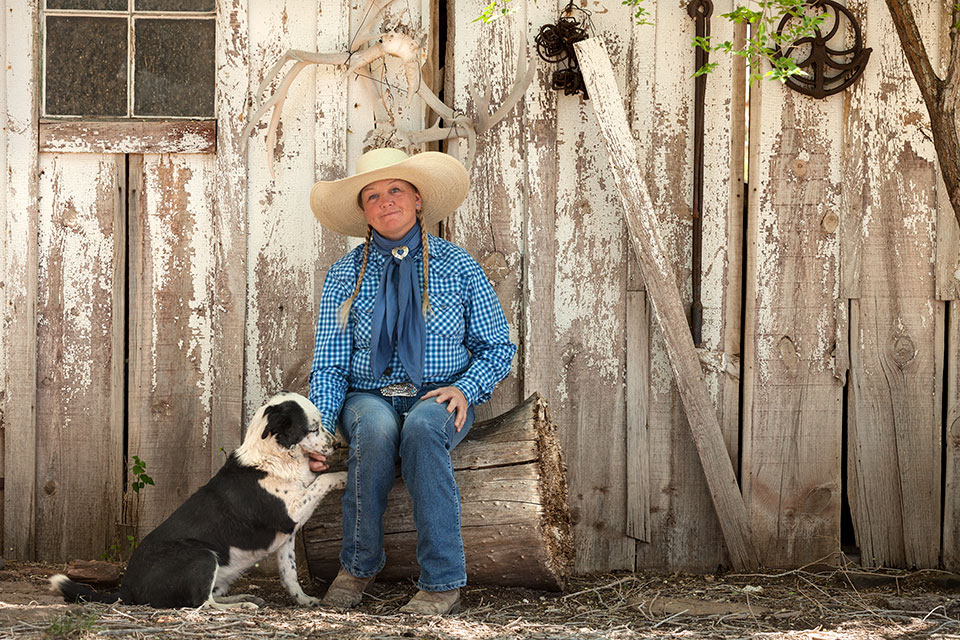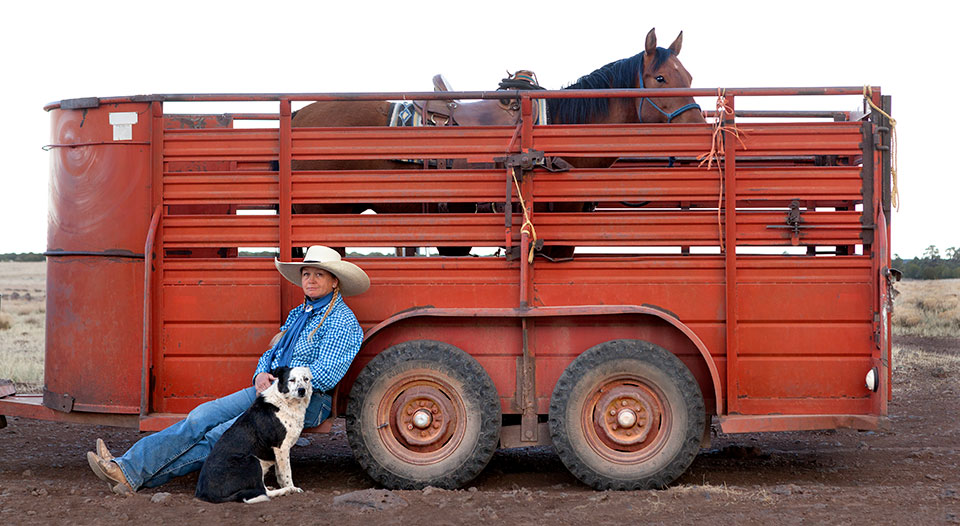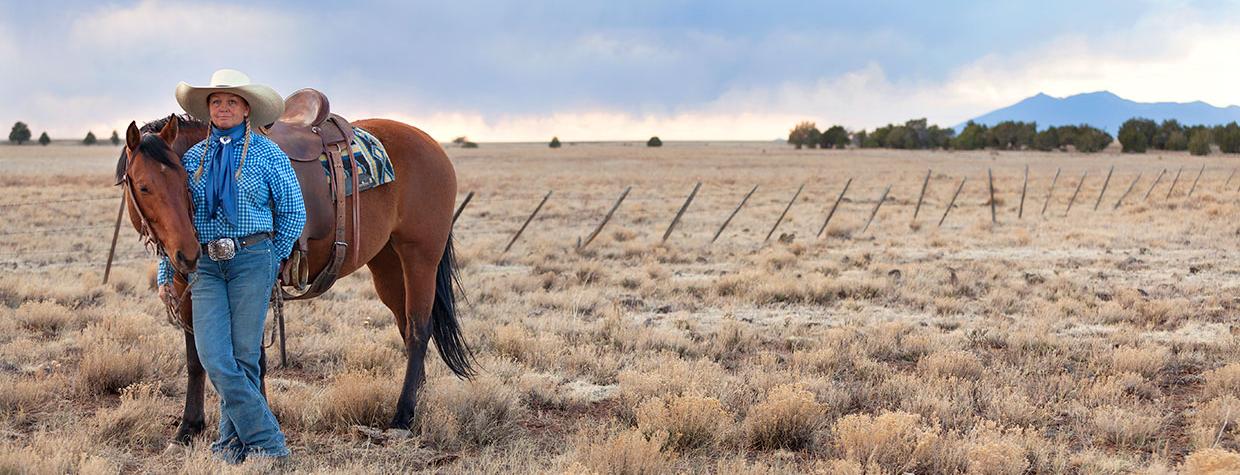There’s no promise of rain on the horizon, none of those bloated blue-black clouds that might deliver a wall of water. Instead, the only things floating in this wide sky are white, wispy, romantic veils — the kind that make for good paintings and sweet songs. They are lovely this April morning, but summer is coming, and the road that heads south from Twin Arrows, Arizona, to the Flying M Ranch is choked with dust.
But there is life here, too, like the thick stands of junipers that harbor Gambel’s quails, Steller’s jays, doves. And on the ranch itself, there are tamarisks, apple and apricot trees, a Verde Valley cottonwood as old as the state of Arizona itself, tall as a dream. There is shade and silence, save for the faraway cry of a hawk and the somewhere whinny and snort of a horse.
I’ve left my hat in the truck, but Sheila Carlson wears hers inside the ranch house, two blond braids hanging long beneath its woven palm brim. We sit at a table covered in books and magazines and pamphlets for Carlson’s nonprofit organization, Cowfolks Care.
Established in 2013, the group’s mission is to provide charitable services and financial assistance to those in the American ranching and agricultural communities in times of devastating illnesses, accidents, job losses or weather-related issues. Its general fund — fed primarily through donations, auctions and other fundraisers — has readily available emergency cash for a family in need. It’s a project that Carlson has stitched to her heart and her hands like a badge.
Ranch owner Kit Metzger pops in to say hello with a smile that says, “Welcome,” and a handshake wrapped in strength. The talk between the two women is natural, familial, easy — likely because the ranch, east of Mormon Lake, has been in the Metzger family since 1894, and today, Metzger and Carlson tend its 90,000 acres.
Carlson’s is a face full of stories, the kind that start slow and pick up steam — like the one about a cow whose baby got stuck during calving. It was a long night, an early morning. The cow made it. The baby didn’t. Carlson had little rest.
“What is bed?” she asks with a smile.

Indeed, maybe tend isn’t the right way to describe what these women do on a daily basis. Life on a ranch is akin in many ways to throwing your body and your brain into sometimes unknown, often hostile territory. Some things are predictable. Others aren’t. Working on a ranch is … work.
There are hand lines to run. Cows to move from pasture to pasture. Fences to mend. Horses to feed and water and saddle and groom. The farrier was to come this day, but he rescheduled. In the meantime, “whatever needs done gets done.” And so, for Carlson, morning can come as early as 2:30 sometimes.
“I’m a little bit different from most people,” she says. “I go by feeling, and if I feel my cows need me down there, I’ll go down there. And four out of five times, it’s a good call. Because they’re my girls.”
And because she’s no stranger to life on a cattle ranch — she’s been working them for the past 18 years.
“It’s all I ever wanted to do,” Carlson says. “I worked a lot of ranches up in Northern California, up in Oregon. I’ve worked Idaho, Washington, Utah, Montana, South Dakota and Arizona. It was something my father talked to me about, and in my 18th year, I was going to head out into the world and find a ranch to work on.”
But her dad passed unexpectedly, and Carlson’s plans changed. She married, had three sons, divorced peacefully. Now, she travels the West, doing the work she loves.
And although Carlson’s lived so many places, Arizona is home.
“When I first came here, it was so different,” she says. “I came down from California and started with the Bar T Bar. For a long time — long before I came down — the red rocks called to me. Then I saw the petroglyphs, the ruins, the old homesteads. I’ve seen old stage stops. It’s part of me.”
Carlson has been at the Flying M for nine years, and as much as she’s certain of her love for the state, she’s also clear about her value in a world that is most commonly associated with men.
“It says ‘cowboy’ on my tax return,” she says.

And the distinction is meaningful. Carlson isn’t a cowgirl, because she’s a woman. And she’s not a cow-woman, “because that doesn’t sound right.” What Carlson does is cowboy — a verb, more than a noun.
“I’ve done pretty much everything,” she says. “I’ve done maintenance on tractors and trailers and lifts and all that. I’ve managed a feed lot. I don’t think people look at you and ask, ‘Are you a woman? Are you a man?’ They look at you and wonder, ‘Can you do this job?’ ”
Most often, she can, although there are a few things she doesn’t necessarily enjoy — fencing with electric wire among them. Still, she feels a distinct and noble tenderness toward the land and the life it provides.
“I know that a lot of people don’t realize how much work the farmers and ranchers throughout the generations have put into these lands to get water from one spot way over to another,” Carlson says. “I don’t think a lot of people recognize where that water is coming from. They want to be in touch with the land, but they’re not really in touch with the land. [Many people] want to say the rancher, the farmer, isn’t good for the land, but I think that’s misguided.”
Indeed, weeks after my visit to the ranch, I’m talking with Carlson about nearby wildfires and what will surely be a very long, very dry summer. Although the fires didn’t touch the Flying M, she knows people who were affected. For Carlson and Metzger, though, the attention was to water — especially in this, the 21st year of Arizona’s debilitating drought.
“We’re hauling big tanks and tubs, making ready to haul water for livestock and wildlife both,” Carlson says. “It’s scary.”
Wyoming was windy, she told me that day on the ranch, but it doesn’t have anything on Arizona. In fact, earlier this year, gusts upward of 75 miles per hour were reported near the Flying M. It’s an element that can fuel those dangerous fires, wreak hell on farmers’ crops and serve as a general plague on the day to day for ranchers.
Still, the elements won’t keep Carlson from her work — because just getting out there is her favorite thing.
“I’m a little bit different from most people. I go by feeling, and if I feel my cows need me down there, I’ll go down there. And four out of five times, it’s a good call. Because they’re my girls.”
— Sheila Carlson
“It’s not even necessarily even being with the cows, but when you’re going to move them to another pasture, you’re going to want to run that pasture first, want to check your fence lines, stuff like that,” Carlson says. “Every time I go into a back pasture, I find things and I have no idea what they are. The other day, over at the bull pasture, I came across someone’s old camp and found a really cool old bottle that’s now in my collection.”
Gifts from the land for someone who gives so much to it.
And while border collies Pippa and Ruby are often at her side, Carlson feels at home alone on the range.
“My dogs are a really close part of my family and my working family,” she says. “I can take my two girls out with me, and I can accomplish exactly what I need to do. It’s almost like they can read my mind.”
But what happens when she needs to clear her mind?
“This is my escape,” she says. “This is where I’m supposed to be.”

